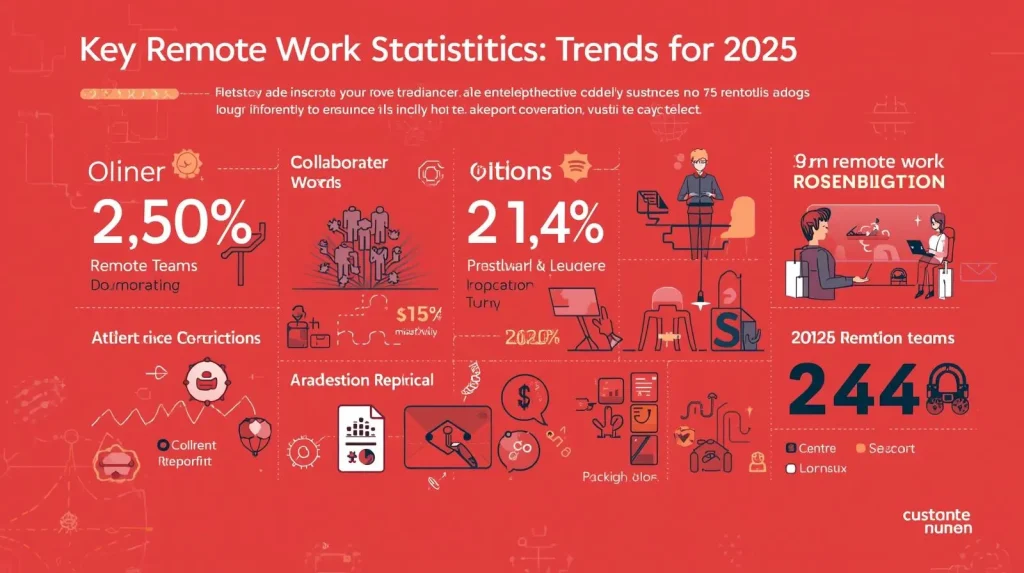Introduction: The Shift to Remote Work in 2025
Remote work impact on client feedback has never been more significant. As businesses go digital-first in 2025, understanding its effect on customer service is key to staying competitive In 2025, remote work is no longer a trend—it’s a permanent shift in how businesses operate. As client expectations rise, so does the need for exceptional customer service and effective feedback systems. In a world where 88% of customers expect personalized, seamless digital experiences (Salesforce 2024 Report), it’s clear: the way businesses interact with clients has changed forever.
With remote teams handling customer inquiries, managing feedback, and executing support tasks, the methods for delivering high-quality service have evolved. Today’s remote work environment demands immediacy, efficiency, and personalized interactions—qualities that directly impact client satisfaction and loyalty. But how exactly does remote work shape client feedback and customer service in this digital-first era? This article dives into how remote teams are transforming the way customer service is delivered, and why remote work has become essential for companies aiming to stay ahead in a competitive market.
For an in-depth look at how remote work is changing career opportunities and client collaboration, check out The Future of Remote Work: Career Opportunities & Client Collaboration.
If you’re looking to take your business to the next level, conversion optimization is a must. Check out Forbes’ latest take on why CRO matters or HubSpot’s guide on conversion strategies to get started today.
What Does Remote Work Mean for Customer Service?
Remote work has fundamentally transformed the landscape of customer service. Historically, customer support teams were centralized in office spaces where businesses had direct control over communication, workflow, and team management. However, with the rise of remote work, businesses are adapting to a new reality where teams are dispersed across different time zones, cultures, and digital channels. While this shift presents some challenges, it also opens the door to significant opportunities for scaling services and improving customer relationships.
Key Changes in Customer Service Due to Remote Work
-
Digital Communication
One of the most significant shifts in remote customer service is the increased reliance on digital communication channels. In-office support teams traditionally interacted face-to-face or over the phone, but with remote work, businesses now use email, live chat, video calls, and social media to communicate with clients. These platforms provide flexibility and speed, allowing teams to respond quickly and effectively across a range of customer needs and preferences. -
24/7 Availability
Remote work opens up the possibility for businesses to provide round-the-clock support. Teams located in different time zones can offer services beyond traditional business hours. For instance, a company with support staff in both North America and Europe can provide support during hours that would otherwise be outside the normal workday. This global availability improves customer satisfaction, as clients can reach out at any time for assistance.

-
Cloud-Based Tools
The shift to remote work has also led to increased reliance on cloud-based tools that enhance collaboration and ensure seamless communication. Customer Relationship Management (CRM) systems, help desks, and live chat tools have become the backbone of remote customer service teams. These platforms enable businesses to track customer interactions, manage inquiries in real-time, and provide consistent service across different locations. -
Scalability and Flexibility
Remote work also offers businesses the flexibility to scale their customer service teams more easily. As businesses grow, they can hire remote agents from a global talent pool, allowing for faster scaling and providing specialized support tailored to different markets. This scalability is particularly important for companies experiencing rapid growth or those expanding into new regions.
How Remote Teams Manage Client Feedback Efficiently
Client feedback is an essential component of maintaining high-quality service and building lasting relationships with customers. With remote teams operating across different time zones and digital channels, gathering and responding to feedback efficiently is more important than ever. Fortunately, with the right tools and strategies in place, remote teams can seamlessly collect, analyze, and act on feedback, ensuring that customer satisfaction remains a top priority.
Tools for Gathering Client Feedback in Remote Environments
-
Customer Surveys
Platforms like SurveyMonkey and Typeform are invaluable for remote teams to gather structured feedback from clients. These tools allow businesses to send targeted surveys that are automatically analyzed, providing valuable insights with minimal effort. For example, a simple post-service survey can capture customer satisfaction levels, product/service feedback, and suggestions for improvement. The real-time data these platforms provide enables teams to act quickly, addressing any issues before they escalate. -
Live Chat Services
Live chat platforms such as Intercom and Zendesk are essential tools for real-time client feedback. When a customer interacts with a support agent, they can leave instant feedback regarding their experience. These platforms can prompt customers to rate their service or answer a quick survey after the conversation ends. This real-time feedback is crucial for remote teams who need to monitor service quality continuously and identify areas where improvements can be made.

3. AI Chatbots
AI-powered chatbots offer another layer of feedback collection. These tools automate the process of gathering initial customer input through conversational forms. They can ask customers for their opinions immediately after an interaction or upon product delivery. After collecting the initial feedback, AI chatbots can seamlessly hand over the conversation to a human agent if further assistance is needed. This ensures that clients receive personalized support while allowing remote teams to manage feedback more efficiently.
The Importance of Proactive Feedback Management
Remote teams are uniquely positioned to leverage these tools to gather feedback proactively. Since they often operate across various digital channels, they can capture feedback through multiple touchpoints, such as email, social media, and messaging apps. By monitoring feedback in real-time and using advanced analytics tools, remote teams can identify and address client concerns before they escalate. This leads to a more responsive and adaptive customer service experience, ultimately increasing client satisfaction and loyalty.
How Remote Work Enhances Client Service Quality
While remote work presents challenges—such as managing different time zones or ensuring team alignment—it also offers unique advantages that can significantly enhance client service quality. By leveraging technology and flexible work structures, businesses can improve efficiency, responsiveness, and overall client satisfaction.
1. Real-Time Collaboration Tools
One of the greatest benefits of remote work is the ability to leverage real-time collaboration tools. Platforms like Slack, Microsoft Teams, and Zoom facilitate instant communication between remote team members, enabling them to address client concerns quickly. These tools allow customer service agents to collaborate seamlessly, ensuring that team members stay aligned and up-to-date on client issues. This collaboration leads to faster resolutions of customer concerns and enhances the overall service experience. Whether it’s responding to emails, joining a quick video call, or brainstorming solutions via chat, real-time communication helps remote teams deliver more efficient client service.
2. Advanced Analytics
Remote work also opens the door for advanced analytics tools to drive better customer service. With call tracking software like VoiceTotal, businesses can gain access to real-time analytics for every customer interaction. By tracking data such as call volume, customer satisfaction scores, and sentiment analysis, remote teams can monitor service performance and identify areas for improvement. These data-driven insights empower teams to make informed decisions faster, addressing customer pain points more effectively. For example, if a certain product or service generates frequent complaints, the team can quickly respond with solutions or escalate the issue for a deeper investigation.
3. Scalability and Flexibility
Remote work inherently provides businesses with scalability and flexibility. By hiring talent from various regions and time zones, businesses can scale their customer service teams as needed to meet demand. This approach gives businesses the ability to handle larger volumes of client requests without compromising service quality. Furthermore, remote work provides the flexibility to adapt quickly to business growth, seasonal demands, or shifts in customer needs.
This scalability means that businesses can expand their client base while still offering personalized, high-quality customer support. Whether it’s adding more agents to handle peak times or utilizing AI-driven tools for automation, remote work ensures that businesses can stay agile while meeting customer needs.
To enhance customer satisfaction through surveys and analytics, see our Customer Survey Pillar.
Real-World Case Study: Remote Work Impact on Client Feedback
Case Study 1: A Growing SaaS Company
A SaaS company based in California transitioned to a fully remote customer support team. By implementing AI-powered call tracking, they began collecting real-time client feedback and using sentiment analysis to improve their service quality. Within 3 months, they saw a 25% increase in customer satisfaction scores and a 20% decrease in service resolution time.

Case Study 2: Online Retail Business
An online retail business adopted remote customer service tools like Zendesk and LiveChat. With remote agents in various time zones, they reduced response times to under 30 minutes, and client feedback surveys revealed a 15% increase in repeat business.
These case studies highlight how remote teams, when equipped with the right tools, can drastically improve client relationships and service delivery.
Common Mistakes in Remote Work and Client Feedback Management
While remote work offers many benefits, there are pitfalls to avoid. Here are common mistakes that SMBs make when managing client feedback in remote environments:
-
Neglecting to Act on Feedback: Collecting feedback is great, but businesses must use it to make tangible improvements.
-
Lack of Clear Communication: Remote teams can struggle with clear communication if systems aren’t properly aligned.
-
Ignoring Client Expectations: Remote teams must still meet the expectations of timeliness, personalization, and human interaction.
-
Overreliance on Automation: While AI tools are helpful, they cannot replace human empathy and judgment.
Future Trends: How Remote Work Will Evolve in Client Feedback

As remote work continues to evolve, we can expect several changes in how businesses handle client feedback:
-
AI-Driven Personalization: With the rise of AI, businesses will be able to offer personalized experiences based on real-time data, leading to more positive feedback and engagement.
-
Voice Search and Feedback: As voice-activated search and devices grow in popularity, businesses will need to optimize for voice search queries and integrate voice-based feedback tools.
-
Integrated Feedback Systems: Future tools will combine live chat, surveys, and AI-driven insights into one seamless platform, improving the client feedback process.
FAQs (Schema Ready)
Q1: How can remote teams effectively manage client feedback?
A: By utilizing tools like Zendesk, SurveyMonkey, and VoiceTotal to track feedback, analyze sentiment, and quickly adjust strategies.
Q2: What are the benefits of remote work for customer service?
A: Remote work allows businesses to hire top talent from anywhere, offering 24/7 support and real-time collaboration for faster service.
Q3: How do AI-powered tools improve client feedback management?
A: AI can analyze customer sentiment, identify trends, and provide actionable insights that help businesses improve service quality and customer retention.
Q4: Can SMBs implement remote work and still maintain high-quality client service?
A: Yes, with the right tools and processes in place, SMBs can scale their client support and improve service quality without geographic limitations.
Q5: What’s the best way to collect customer feedback in remote settings?
A: Use surveys, live chat, call tracking software, and sentiment analysis to understand client pain points and enhance service delivery.
Conclusion: The Future of Client Feedback in Remote Work
The rise of remote work in 2025 isn’t just a shift in how we work — it’s a transformation in how businesses deliver customer service. By utilizing the right tools and understanding the power of client feedback, SMBs can stay ahead of competitors, improve service quality, and boost client retention. Remote teams, empowered with smart tools like call tracking software and AI analytics, have the ability to provide world-class service, no matter where they are.
